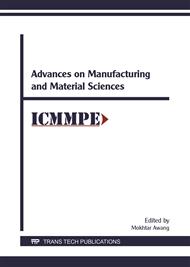p.81
p.86
p.93
p.100
p.111
p.118
p.125
p.133
p.139
Critical Thrust Force for On-Set Delamination of Hybrid FRP Composite during Drilling Process
Abstract:
Hole quality is one of the important criteria for hybrid composite components when assessing drilling behaviour because it influences the strength of composite parts post assembly. Nonetheless, some unique characteristics of hybrid Fibre-Reinforced Polymer (FRP) composites make them difficult to obtain the required quality and strict final dimensional accuracy. Based on previous studies, delamination has been recognized as one of the critical failure mechanisms in the drilling operation of FRP composites. It can often be the limiting factor for the final composite materials applications. Thus, in order to achieve a delamination-free in the drilling of hybrid FRP composites, an analytical model and a series of thrust force experiments are endeavoured in this study. The main purpose of the model is to compute the critical thrust force at the on-set of delamination during the drilling process. Results of this analytical study indicated that the delamination damage can be alleviated if the applied thrust force is lower than the critical thrust force value. Importantly, a good agreement was evident between the estimated critical thrust force and the measured thrust force in this particular study.
Info:
Periodical:
Pages:
111-117
Citation:
Online since:
June 2017
Authors:
Price:
Сopyright:
© 2017 Trans Tech Publications Ltd. All Rights Reserved
Share:
Citation:


